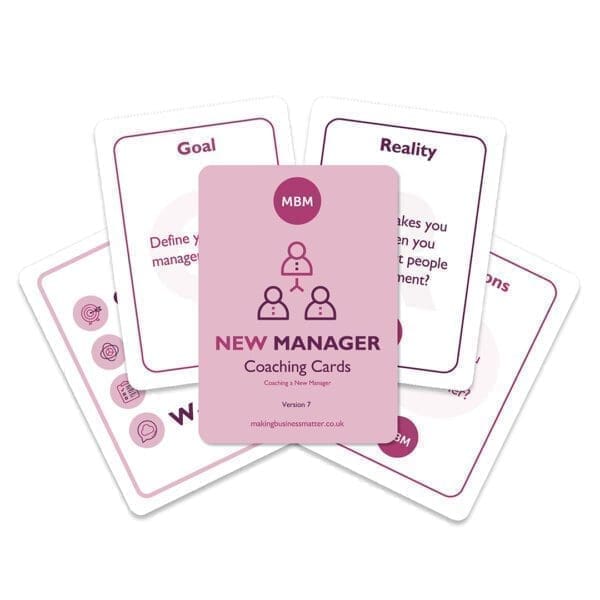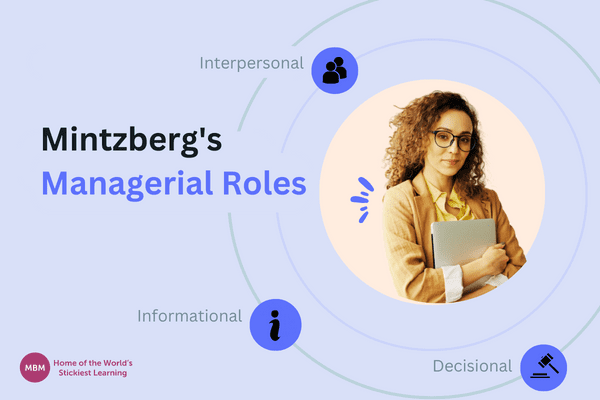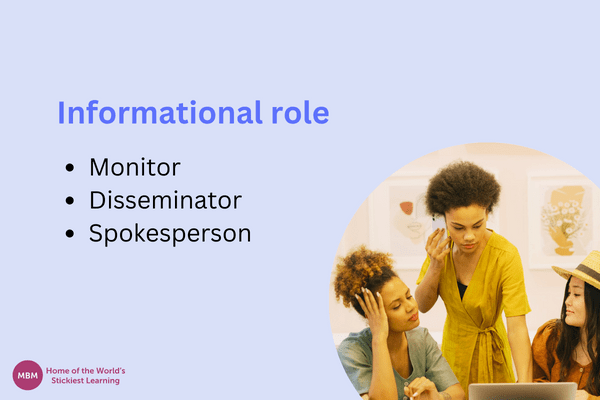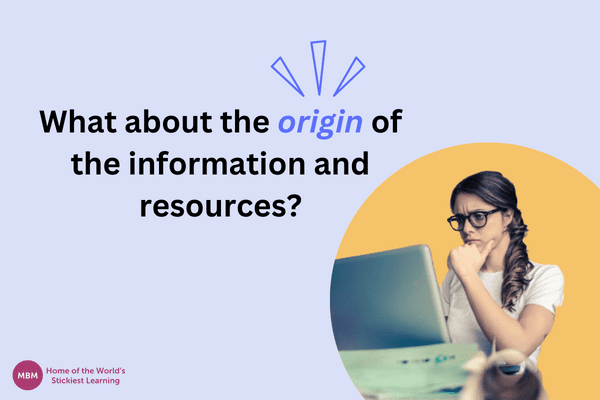Understanding the 10 Types and Their Impact on Team Leadership
So, you’re a manager? Are you a leader who’s previously encountered Mintzberg’s managerial roles?
Well, this article sets out to define the 3 Primary groups and the 10 managerial roles and how they could help create an impact within your entire organisation.
Also, towards the end of the article, we give 10 real-life examples of Mintzberg’s managerial roles in action.
Jump to Sections:
- 1- What are Mintzberg’s Managerial Roles and Why Do They Matter?
- 2- What Are the 3 Primary Groups?
- 3- The Ten Mintzberg’s Managerial Roles Identified
- 4- Interpersonal Roles
- 5- Informational Roles
- 6- Decisional Roles
- 7- Exploring Internal And External Sources
- 8- Defining Internal and External Relationships for Mintzberg’s Managerial Roles
- 9- The Benefits of Understanding Mintzberg’s Managerial Roles for Team Leadership
- 10- So, What Can You Do Today?

>> New manager coaching cards <<
>> Access on Amazon <<
1) What are Mintzberg’s Managerial Roles and Why Do They Matter?
Mintzberg’s Managerial Roles is a theory developed by Henry Mintzberg in the 1970s that describes the different roles that managers play in an organisation.
Above all, the theory is based on his observation of managers in various organisations and how they operate. It outlines 10 distinct managerial roles divided into interpersonal, informational and decisional.

These roles are important for understanding how managers interact with their employees, as well as how they can effectively manage their teams and achieve organisational goals.
Even more, by understanding these managerial roles, organisations can better allocate resources to ensure the successful management of their teams.
2) What Are the 3 Primary Groups?
Here are the three categories that act as an umbrella for the ten managerial responsibilities. It’s worth paying attention to the three categories and how they relate to your organisation:
Sticky Learning ® is 7 times more effective than 1-day training courses. Plus, you will get a Chain of Evidence proving your Return on Investment. Discover soft skills training that changes behaviours long term.

#1- Interpersonal Roles
The first group of Mintzberg’s managerial roles is Interpersonal. These roles refer to how managers interact with their subordinates, peers, and other stakeholders. For the most part, these roles enable managers to establish and maintain effective working relationships, which are essential for organisational success.
#2- Informational Roles
The second grouping, informational roles pertain to the acquisition, processing, and dissemination of information. Particularly, managers are responsible for staying informed about the organisation’s internal and external environment and leveraging this information to make informed decisions.
#3- Decisional Roles
This is the last group of Mintzberg’s managerial roles. Decisional roles encompass the various decisions that managers must make to ensure the smooth functioning of the organisation. Specifically, these roles involve assessing situations, evaluating alternatives, and selecting the best course of action.
3) The Ten Mintzberg’s Managerial Roles Identified

Mintzberg’s ten roles offer a comprehensive view of the responsibilities, activities and skills that are required for effective management.
In brief, the 10 types of managerial roles, as identified by Henry Mintzberg, include the figurehead role, leader role, liaison role, monitor role, disseminator role, spokesperson role, entrepreneur role, disturbance handler role and resource allocator.
Each type of managerial role has its unique set of duties and responsibilities that can help managers manage their teams more effectively.
Therefore, by exploring the 10 types of Mintzberg’s managerial roles in depth we can gain a better understanding of how to use these roles to our advantage when managing teams.
Specifically, we will look at how each type contributes to effective leadership and how it can be used to create an environment where employees feel empowered and motivated.
By understanding each type of managerial role we will be able to make better decisions when it comes to managing our teams.
Overview of Mintzberg’s Management Roles
Mintzberg’s Management Roles provide a framework defining a successful manager’s ten essential roles. These roles are categorised into three primary groups: interpersonal, informational, and decisional roles. In this guide, we will examine each of the roles and provide actionable insights for managers to excel in these areas.
4) Interpersonal Roles

1. Figurehead
As a figurehead, a manager represents the organisation in an official capacity, performing ceremonial and symbolic duties. This role involves attending important events, signing legal documents, and acting as the face of the organisation.
Key Actions:
- Maintain a professional image.
- Engage with stakeholders.
- Represent the organisation at official functions.
2. Leader
The leader role focuses on directing and guiding team members to achieve organisational goals. This includes setting clear expectations, providing feedback, and fostering a positive work environment.
Key Actions:
- Set performance goals.
- Coach and mentor team members.
- Encourage open communication and collaboration.
3. Liaison
A liaison establishes and maintains relationships with external stakeholders, such as vendors, customers, and industry peers. This role requires strong networking skills and the ability to build trust with various parties.
Key Actions:
- Attend industry events.
- Build relationships with key stakeholders.
- Collaborate with external partners.
5) Informational Roles

4. Monitor
As a monitor, a manager continuously gathers and analyses information to stay informed about industry trends, competitors, and the internal performance of the organisation.
Key Actions:
- Track key performance indicators (KPIs).
- Conduct market research.
- Stay updated on industry news and developments.
5. Disseminator
The disseminator role involves sharing relevant information with team members, ensuring that everyone is well-informed and aligned with organisational objectives.
Key Actions:
- Share updates and insights with the team.
- Facilitate knowledge-sharing sessions.
- Encourage open channels of communication.
6. Spokesperson
A spokesperson represents the organisation to external parties, such as the media, investors, and customers. This role requires excellent communication skills and the ability to convey the organisation’s mission, vision, and values.
Key Actions:
- Develop and deliver key messages.
- Engage with the media and public.
- Represent the organisation in external communications.
6) Decisional Roles

7. Entrepreneur
In the entrepreneur role, a manager identifies opportunities for innovation and growth, driving the organisation forward. This role involves strategic planning, resource allocation, and risk management.
Key Actions:
- Identify and evaluate growth opportunities.
- Develop and implement strategic plans.
- Allocate resources to support innovation.
8. Disturbance Handler
A disturbance handler deals with unexpected challenges and crises, developing solutions to mitigate risks and minimise negative impacts on the organisation.
Key Actions:
- Identify potential threats and vulnerabilities.
- Develop contingency plans.
- Resolve conflicts and manage crises.
9. Resource Allocator
The resource allocator role involves making decisions on how to best allocate resources, such as finances, personnel, and equipment, to maximise efficiency and effectiveness.
Key Actions:
- Assess resource needs.
- Prioritise investments and expenditures.
- Optimise resource allocation for maximum impact.
10. Negotiator
As a negotiator, a manager resolves conflicts and reaches agreements with various stakeholders, such as employees, suppliers, and customers. This role requires strong negotiation and conflict-resolution skills.
Key Actions:
- Develop negotiation strategies.
- Build consensus among stakeholders.
- Resolve conflicts and reach mutually beneficial agreements.
7) Exploring Internal And External Sources

Internal and external sources refer to the origin of the information and resources that managers need to effectively perform their duties.
Understanding and leveraging both internal and external sources is essential for managers to make well-informed decisions and maintain the organisation’s overall health.
Internal Sources:
Internal sources are the information and resources that originate within the organisation. These sources can provide valuable insights into the company’s performance, capabilities, culture, and employee morale. Examples of internal sources include:
- Employee feedback and suggestions.
- Internal reports and performance metrics.
- Company policies and procedures.
- Organisational Structure and Hierarchy.
- Financial data and budgetary information.
When managers tap into internal sources, they can better understand the strengths and weaknesses of their organisation, identify areas for improvement, and implement strategies to enhance overall performance.
External Sources:
External sources are the information and resources that come from outside the organisation. These sources can provide crucial context on the industry, competitors, market trends, and other factors that can impact the organisation’s success. Examples of external sources include:
- Industry reports and market research.
- Competitor analysis and benchmarking.
- News articles and press releases.
- Government regulations and policies.
- Customer feedback and reviews.
By staying attuned to external sources, managers can anticipate and respond to changes in the market, identify potential opportunities and threats, and position their organisations for sustained success.
8) Defining Internal and External Relationships for Mintzberg’s Managerial Roles

Here we are referring to the connections and networks managers maintain within the organisation and with external stakeholders.
Nurturing and leveraging these relationships is essential for managers to effectively execute their duties, foster a collaborative environment, and achieve organisational goals.
Internal Relationships:
Internal relationships are the connections managers establish with their subordinates, peers, and other members of the organisation. By cultivating strong internal relationships, managers can foster teamwork, facilitate communication, and enhance overall organisational performance. These relationships involve:
- Building trust and rapport with team members.
- Providing guidance, mentorship, and support to subordinates.
- Collaborating with peers to share information, resources, and best practices.
- Engaging with higher-ups to gain insights, seek approval, and ensure alignment with organisational objectives.
Effective internal relationships enable managers to create a positive work environment, motivate employees, and ensure everyone works cohesively towards shared goals.
External Relationships:
External relationships are the connections managers maintain with stakeholders outside the organisation, such as clients, suppliers, competitors, regulators, and industry partners. All in all, these relationships are crucial for gathering information, identifying opportunities, and addressing challenges that can impact the organisation’s success. Building and maintaining external relationships involves:
- Networking with professionals in the industry to exchange knowledge and resources.
- Collaborating with suppliers and vendors to negotiate favourable terms and ensure a reliable supply chain.
- Engaging with customers to gather feedback, address concerns, and maintain loyalty.
- Staying updated on regulatory changes and maintaining a positive relationship with government agencies.
- Participating in industry events, conferences, and forums to represent the organisation and identify potential partnerships.
By nurturing external relationships, managers can access valuable insights, stay ahead of industry trends, and make well-informed decisions that drive the organisation’s growth and success.
9) The Benefits of Understanding Mintzberg’s Managerial Roles for Team Leadership

Understanding Mintzberg’s managerial roles is essential for effective team leadership. This framework provides a comprehensive set of roles that managers must fill to ensure the success of their teams.
Indeed, by understanding these roles, leaders can identify areas where they need to focus their efforts to improve team performance and productivity.
Additionally, by recognising the different responsibilities associated with each role, they can be better equipped to respond quickly and effectively when challenges arise.
Ultimately, this understanding of Mintzberg’s managerial roles is key for effective team leadership and improved team performance.
Common Pitfalls to Avoid When Applying Mintzberg’s Managerial Roles in Teams
Applying Mintzberg’s managerial roles in teams is a great way to ensure effective leadership and efficient team collaboration. However, certain pitfalls must be avoided to ensure the team functions optimally.
Common mistakes such as poor delegation skills, ineffective teams and leadership blunders can lead to a failure in applying Mintzberg’s managerial roles correctly. Therefore, managers and leaders need to be aware of these pitfalls to avoid them and ensure the success of their teams.
10 Examples of Mintzberg’s Managerial Roles in Action
These ten examples showcase the versatility and importance of Mintzberg’s managerial roles in the workplace. Without a doubt, by embracing these roles managers can effectively navigate the complexities of their position and drive their organisation towards success.
1. Conducting Weekly Team Meetings (Interpersonal Role – Leader):
To foster open communication and alignment, a manager can initiate weekly team meetings where employees can share updates, discuss challenges, and brainstorm solutions. Moreover, this practice demonstrates the manager’s commitment to supporting their team while creating a platform for collaboration and problem-solving.
2. Attending Industry Conferences (Interpersonal Role – Liaison):
By attending industry conferences, a manager can build connections with other professionals, gain insights into market trends, and discover potential partnership opportunities. Furthermore, this external networking helps the manager stay informed and bring fresh ideas and perspectives back to the organisation.
3. Organising Employee Training Sessions (Informational Role – Disseminator):
A manager can arrange training sessions to help employees develop new skills or improve existing ones. By disseminating knowledge and resources, the manager empowers the team to perform better and contribute to the organisation’s success more effectively.
4. Tracking Competitor Activities (Informational Role – Monitor):
To stay ahead of the competition, a manager can regularly research and analyse competitors’ activities, such as product launches, marketing strategies, and customer feedback. Importantly, this vigilance enables the manager to make well-informed decisions and adjust their strategies accordingly.
5. Implementing Innovative Processes (Decisional Role – Entrepreneur):
A manager can identify areas of improvement within the organisation and introduce innovative processes to enhance efficiency and productivity. For example, they might implement a new project management tool or streamline communication channels to reduce bottlenecks.
6. Resolving Interdepartmental Conflicts (Decisional Role – Disturbance Handler):
When conflicts arise between departments, a manager can step in as a mediator, facilitating open dialogue and helping the parties involved reach a mutually beneficial resolution. This decisive action fosters a harmonious work environment and minimises disruptions to productivity.
7. Allocating Resources for a New Project (Decisional Role – Resource Allocator):
When starting a new project, a manager must carefully determine the required resources, such as budget, personnel, and time. As a result of prioritising and allocating resources efficiently, the manager can ensure the project’s success while maintaining a balanced workload for the team.
8. Representing the Company at a Charity Event (Interpersonal Role – Figurehead):
By participating in community events, a manager can demonstrate the organisation’s commitment to social responsibility and foster goodwill among stakeholders. Furthermore, as the company’s representative, the manager can create a positive image and contribute to the organisation’s reputation.
9. Presenting a Business Update to Investors (Informational Role – Spokesperson):
A manager may need to deliver presentations or updates to external stakeholders, such as investors or shareholders. By presenting clear, concise, and accurate information, the manager can convey confidence in the organisation’s performance and prospects.
10. Negotiating a Contract with a Supplier (Decisional Role – Negotiator):
When establishing agreements with suppliers, a manager must negotiate favourable terms that balance cost, quality, and reliability. By building rapport and employing effective negotiation tactics, the manager can secure beneficial deals that contribute to the organisation’s long-term success.
10) So, What Can You Do Today?

Based on Mintzberg’s Managerial Roles, here are three actions you can take to improve your own managerial style:
1. Self-assessment and role identification:
Analyse your current managerial practices and identify which of the ten Mintzberg managerial roles you excel in and which ones might need improvement.
In particular, determine how well you are performing in the interpersonal, informational, and decisional categories. This self-assessment will provide you with a clear understanding of your current managerial style and help you identify areas that need improvement.
2. Develop a personal action plan:
Based on the self-assessment, create a personal action plan to enhance your performance in the identified weak areas.
Set specific, measurable, achievable, relevant, and time-bound (SMART) goals for improvement in each role.
For example, if you need to work on your liaison role, set a goal to attend more networking events or initiate collaborations with external stakeholders.
Subsequently, outline the necessary steps, resources, and support needed to achieve these goals.
3. Develop a personal action plan:
To improve your managerial style, it is crucial to seek feedback from your team members, peers, and superiors.
Ask them for their input on your performance in the various Mintzberg roles and request suggestions for improvement.
Additionally, consider finding a mentor with experience in the roles you are looking to strengthen.
Their guidance, advice, and support can help you navigate the challenges associated with improving your managerial skills.
Finally, Conclusion
In conclusion, Mintzberg’s managerial roles offer a comprehensive blueprint for managers seeking to excel in today’s dynamic business landscape.
All in all, by embracing interpersonal, informational, and decisional roles, managers can effectively navigate their complex challenges, fostering a cohesive and high-performing work environment.
Importantly, these roles provide a robust framework for leaders to better understand their responsibilities, enabling them to inspire their teams, make well-informed decisions, and maintain strong relationships with both internal and external stakeholders.
Also, as the business world continues to evolve, managers must adapt and expand their skill sets. And by internalising Mintzberg’s managerial roles and applying them in the workplace, managers can cultivate a proactive and agile mindset that is essential for long-term success.
Given the rapid technological advancements and ever-shifting market demands of our era, it is essential that leaders embody certain roles. By doing so, they can better equip themselves to drive innovation, anticipate challenges, and steer their organizations towards a prosperous future.
Ultimately, Mintzberg’s managerial roles serve as a valuable guide for managers at all levels, providing actionable insights that can elevate their leadership abilities and contribute to organisational success. By incorporating these roles into their daily practices, managers can unlock their full potential and pave the way for a thriving, resilient, and adaptive business environment.




